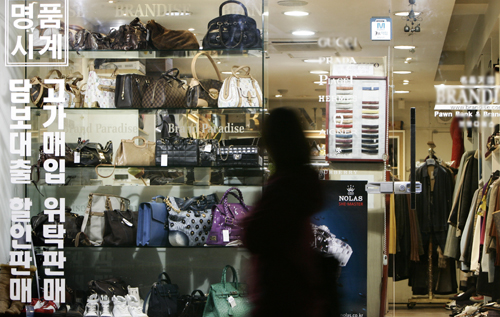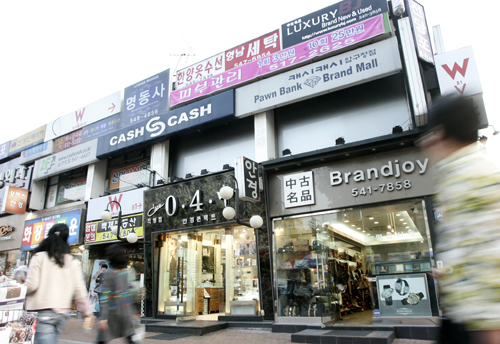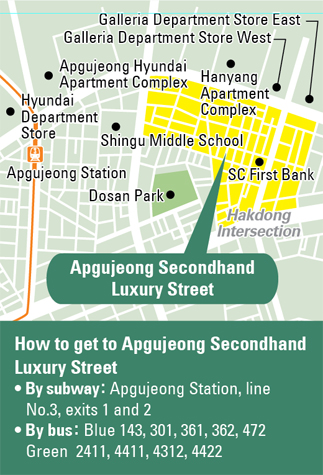Nothing second-rate in secondhand district

A woman passes by a secondhand luxury brand shop in Apgujeong-dong’s Rodeo Drive area last week. By Oh Sang-min
“I have a seon [a meeting with a prospective spouse] to go to in two weeks but I don’t have a nice, formal bag to go with my outfit,” she said, browsing the windows of secondhand luxury shops across the street from Galleria Department Store in Apgujeong-dong, southern Seoul. “I don’t want to spend too much on something that I won’t use frequently but I don’t want to buy anything cheap-looking for the date either.”
She debated between a small Bally chain strap bag and a vintage Chanel shoulder bag, but decided to defer deciding until she got a second opinion from her friend.
“We saw many customers early this year who were more hesitant to go to department stores for luxury items as the depreciation of the won against other currencies doubled or tripled the price of foreign luxury brand items sold in Korea,” said Shin Jong-jin, owner of Koibito, a secondhand luxury shop in Apgujeong-dong.
He started the business back in 2000 and now has four branches in Seoul in Apgujeong, in Gangnam, in front of Ewha Womans University and in Nonhyeon-dong. He also has an online store.
Why this area? “Apgujeong-dong is home to many upper-class Korean families and there has always been a high demand for luxury items here, hence the success of luxury brands in the area’s Galleria and Hyundai department stores as well as luxury boutiques,” he explained, wiping the glass display in his store holding rows of high-end watches including those from Rolex, Cartier and Hermes.

Secondhand luxury shops stand in Apgujeong opposite the Galleria Department Store. By Oh Sang-min
Along the area’s “Rodeo Drive” fashion street, across from the Galleria Department Store’s main building, there are a little less than 30 secondhand luxury shops.
Although the actual address of these shops mostly read Sinsa-dong, the owners consider the stores “Apgujeong-dong” shops because they are in and near Apgujeong-dong’s “Rodeo Drive,” which has been synonymous with “Apgujeong-dong luxury” for many Koreans.

Choi Soung-suk, left, owner of secondhand luxury shop Grand Paris, looks over luxury brand items in her store last week. By Oh Sang-min
Shop owners said that during the formation of the secondhand luxury shop street many of the high-end luxury boutiques in Apgujeong’s Rodeo Drive area moved to the nearby Cheongdam area.
Last year, when the global financial crisis hit Korea along with the rest of the world, shop owners say more people came to their stores selling items, instead of buying.
“Last year, for every four people who came to the store to buy something, seven came to sell something,” said Do. However, the global economic crisis this time has not affected the secondhand luxury business according to the shop owners. In fact, a majority in the Apgujeong area say that it has helped their business.
“Last year, as the won depreciated against the yen, many Japanese secondhand luxury shop owners came to Korea and bought items in bulk,” said Do.

Depending on the age and condition of the product, items can go for 10 percent to 50 percent off the price of new products in department store windows. For example, a quilted classic black Chanel 2.55 bag goes for around 4 million won ($3,447) to 4.5 million won retail these days. In Koibito, the same bag - used, but in mint condition - sold for a little under 2 million won this month.
After years in business, owners say that they have become semi-experts in weeding out knockoffs. “We occasionally run into people who try to sell fake items to us,” said Choi Soung-suk, owner of Grand Paris, another secondhand luxury shop in Apgujeong-dong Rodeo Drive. “There are a few key methods to find out if a bag is fake. The first, most common method of deciphering is the code number which is hidden inside the lining of bags. Then there is leather quality, the condition of zippers and lining. However, if we are on the fence about an item, we take it to an expert.”
There are more and more intricately made knockoffs these days, according to the shop owners.
“I have come across many fake watches that are real on the outside but fake on the inside. It is getting harder and harder to detect fakes,” said Shin.
By Cho Jae-eun [jainnie@joongang.co.kr]










with the Korea JoongAng Daily
To write comments, please log in to one of the accounts.
Standards Board Policy (0/250자)